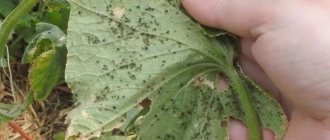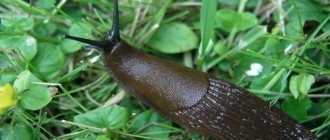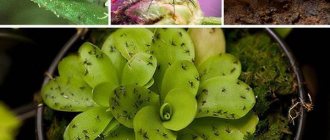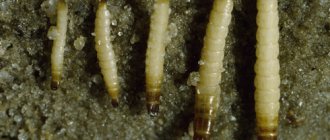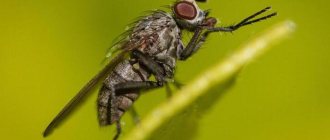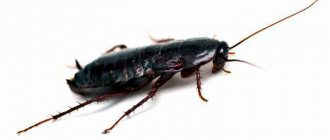Why are spider mites dangerous on cucumbers in greenhouses?
The appearance of spider mites on cucumbers in a greenhouse cannot be called a pleasant surprise. A small insect measuring no more than a millimeter cannot always be seen immediately. Typically, gardeners understand that a pest has settled on cucumbers after they detect its signs on the foliage. The danger is that ticks multiply at high speed. As a result, in just a week the problem acquires colossal proportions.
On cucumbers, pests prefer to settle under the foliage. The most favorable conditions have been created for them in this place. The first sign of danger is the appearance of light spots, and then spots on the foliage. After some time, cobwebs are found on the plants. The problem may not seem serious, but soon the plant begins to wither and then die. The tick must be removed immediately. It is dangerous for many plants.
Why and how do ticks get into the greenhouse?
The main reason for the appearance of mites on cucumbers is high temperature and low humidity inside the greenhouse. Most of all, pests love fattening plants that increase green mass. This most often occurs when there is an excess of nitrogen in the soil. At the same time, plants properly fed with phosphates are of no interest to the pest.
Expert opinion
Istomina Karina Bogdanovna
Agronomist with knowledge and skills in growing vegetables
Ticks get into the greenhouse with soil and new seedlings. Often vegetable growers themselves bring insects into the premises on clothes or shoes.
Where does it come from?
Spider mites look for optimal conditions for life. It does well in dry and sunny climates. At high temperatures it multiplies quickly, so it often appears in greenhouses. Mites can crawl onto cucumbers from other plants. In addition, parasites often overwinter in the top layer of soil, in crevices and on greenhouse frames. The disease can be introduced with humus.
Small insects enter the greenhouse during ventilation. Gardeners themselves spread mites by bringing them on tools from another cultivated area.
Attention! It is impossible to protect your garden or greenhouse from parasites. Therefore, it is important to know what measures exist to combat spider mites.
Methods for controlling spider mites
There are several ways to destroy the pest. The choice specifically depends on the degree of plant infestation by the pest.
Chemicals
Since mites are not insects but arachnids, traditional insecticides are not effective enough against them.
To combat these pests it is necessary to use acaricides:
Apollo
Kills adult insects and larvae. It does not directly affect the eggs, but persists on the leaves after treatment with the solution for up to 4 weeks. Therefore, the hatched larvae also die.
Karbofos
A highly effective drug with a wide spectrum of action. The working solution is prepared from 40 g of powder per 10 liters of water. Treatment is carried out 3 times with an interval of 5 – 7 days.
Anti-mite
A very powerful specialized drug. As a rule, one treatment is enough to destroy insects and eggs that have settled on the plant.
Neoron
The advantage of this drug is that it is safe for bees, so it can be used if the greenhouse is located next to the apiary.
Sunmite
Effective against spider mites at all stages of pest development. The period of protective action of the drug is up to 8 weeks. The death of insects occurs within 15 minutes after spraying the plantings.
When working with poisons indoors, take precautions. When processing plants, wear a mask to protect the respiratory tract and goggles. Open doors and vents in the greenhouse to allow fresh air to enter.
Spider mites quickly get used to poisons. If you managed to rid the plants of insects in 2 treatments, you should not use the same preparation if it is re-infested: it will no longer have an effect on the mite.
Biological products
Chemicals can be used to treat cucumbers only before the ovary begins to form. Further processing leads to the accumulation of harmful substances in the fruits. Therefore, if a mite has attacked cucumbers during fruiting, it must be combated using biological means.
The following biological products are effective against spider mites, but are safe for humans:
Agravertine
A nerve agent. Destroys adults and larvae, depriving them of the opportunity to feed. Insect death occurs within 6–10 hours after treatment. The concentration of the solution depends on the level of mite infestation. If there are few insects, 1 ml per 1 liter of water is enough. If there are a large number of insects on cucumbers, use a solution of 8 ml of the drug per 1 liter of water.
Bi 58
The active ingredient of the drug is dimethoate - an ester of phosphoric acid. Easily penetrates the chitinous cover of insects and causes their death. The drug is absorbed into plant tissue and continues its poisonous effect on pests for 25–30 days. The solution is prepared from 1 ml of product per 1 liter of water. A higher concentration is not permissible as it can cause leaf burn.
Kleschevit
Insectoacaricide of intestinal contact action based on aversectin. Paralyzes the nervous system of pests. The death of the tick occurs after 3–6 days. The protective effect lasts 7 days, then the poison disintegrates. Treatment of cucumbers with Kleschevit is carried out 2 times with an interval of 20 days. The concentration of the solution is 1 ml per 1 liter of water.
Aktofit
A unique biological insecto-acaricide. Contains a neurotoxin that is harmful to insect pests. Once a parasite enters the body, it completely deprives it of the ability to move and feed. The death of insects occurs after 4–5 days. To treat cucumbers, 4 ml of the drug is diluted in 1 liter of water.
Vertimek
Insectoacaricide based on neurotoxin. Insects die when the drug comes into contact with them directly during spraying and after eating plant parts treated with poison. Mite activity stops one day after treatment.
The drug is not addictive to pests. Safe for humans, but extremely toxic to bees. The protective effect of Vermitec is about 3 weeks. The working solution is prepared from 3 ml of product per 10 liters of water.
Attracting Natural Enemies
Effective protection of cucumbers from spider mites is the introduction of predatory insects into the greenhouse. The most dangerous enemies of the pest are phytoseiulus and amblyseius mites. Test tubes with these insects can be purchased at specialized gardening stores.
Predators eat adult spider mites, larvae and eggs. After complete destruction, the pests die. When used correctly, phytoseiulus and amblyseius destroy 95 - 98% of spider mites. To effectively protect plantings, 10–15 predators must be populated per 1 sq./m of greenhouse.
Folk methods of struggle
Remedies prepared according to folk recipes are effective only at the beginning of a tick infection. But their advantage is that they are absolutely safe for human health.
Therefore, if there are few pests on cucumbers, you can use one of the following remedies:
Infusion of potato tops
Pour 1.5 kg of chopped tops into 10 liters of water, leave for 4-5 hours, strain and use for spraying.
Ammonia solution
Dilute 30 ml of ammonia in 10 liters of water. Spray the cucumber leaves, soil and walls of the greenhouse.
Decoction of tomato tops
Pour 4 kg of crushed raw materials into 10 liters of boiling water and cook over low heat for 30 minutes, then strain. For every 2 liters of broth, add 30 g of grated laundry soap and stir well.
Wormwood infusion
800 g of herb, pour 10 liters of water, leave for 2 days. Then cook for half an hour, cool, strain and dilute 1:1 with water. Treat plantings every 7 days.
Mustard infusion
Pour 200 g of powder into 10 liters of water, leave for 10 - 12 hours. Then strain and spray the plants.
Garlic infusion
Leave 150 g of dry leaves and husks in 10 liters of water for 24 hours, strain and immediately treat the bushes.
Whey solution
To 7 liters of water add 3 liters of whey, 3 tbsp. l. ammonia, 5 tbsp. l. liquid soap (tar or laundry soap).
The prepared mixture is generously watered on the cucumber foliage every 10 to 14 days until the poutine mite is completely destroyed.
Symptoms of the lesion
It is difficult to detect the pest at first. Settling on the foliage, it sucks out all the juices from the plant. Ultimately, this leads to a weakening of the culture. The arthropod is the cause of other diseases. Along with it, gray rot often appears on the plant. It has to be removed along with the mite in order to preserve the planting.
It is unreasonable to wait for large-scale manifestations to appear. Periodically it is worth inspecting the back of the leaves. As soon as you notice light spots, start fighting the tick. The spots increase in size very quickly. Gardeners also do not immediately notice the presence of a barely noticeable web. They draw conclusions about the presence of a problem when the entire plant turns yellow. Cucumbers stop growing.
Signs of a pest presence
It is important to take action at the first symptoms. On cucumbers, spider mites are identified by light spots on the leaves. They form at puncture sites through which insects suck sap from plant cells.
When the colony grows, a thick web will appear. At this stage, cucumbers cannot always be saved. Leaves, ovaries, and vines quickly dry out, and the harvest is lost.
The signs that there are already spider mites on cucumbers are quite clear. Here's what you need to pay attention to:
- The lower part of the leaf is where the mite first settles. Arm yourself with a magnifying glass; without it you won’t see anything. If you notice small red, orange, brown, yellow spiders, it’s time to start processing.
- On the front part there are multiple light dots, which merge over time - this is a sign of the presence of a spider mite. The defeat occurs like an avalanche - just yesterday nothing threatened the harvest, but after 7 days you can forget about it. The offspring of one female in 2 weeks can amount to several thousand new individuals. This means that measures must be taken immediately.
- Cobwebs in the axils and on the tops of shoots are an advanced stage.
At the initial stage, leaves with a detected mite are torn off. If the pest has multiplied, delaying treatment can result in crop loss.
More often, spider mites appear on plants overfed with nitrogen. If a pest is detected, you must stop fertilizing with fertilizers that contain this element. Potassium and calcium can be used.
How to deal with parasites on cucumbers in a greenhouse?
To combat spider mites, folk remedies and chemicals are used.
Folk remedies and recipes
In case of large-scale defeats, there is no need to rely on folk remedies. They work when it comes to the initial stage of the problem. They are used when the first signs are detected. Gardeners recommend immediately plucking off the affected leaves. They are put in a bucket, and then taken away from the garden and burned. A web remains on the plant and is much more difficult to collect. To do this, use a soapy sponge. Only after the initial treatment can you begin to fight directly.
The most effective means include:
- garlic tincture. To prepare, take 50 grams of garlic cloves. They are passed through a press (can be crushed in any way) and infused in a bucket of liquid. Cucumber lashes should be processed in calm weather. It is better to choose the evening time so as not to burn the foliage in the hot conditions of the greenhouse;
- hot peppers. The vegetable is good for fighting ticks. It is cut into pieces and filled with liquid. The tincture is boiled over fire for an hour. It is prepared on the basis that for every 0.5 liter of water you need to take 50 grams of pepper. The prepared liquid is not used in its pure form. After cooling, a third of the solution is diluted in a bucket of water;
- hydrogen peroxide (3%). The pharmaceutical product is diluted in water. Three tablespoons of peroxide are mixed with three liters of liquid. All affected plants are sprayed with the solution. Treatment must be repeated after 3-7 days;
The higher the temperature in the greenhouse and outside, the more often spraying is done.
- tobacco dust. Leaves moistened with water are powdered with the dry mixture;
- ammonia. A teaspoon of ammonia is diluted in a liter of water. The resulting mixture is treated with plants.
Gardeners recommend adding liquid soap to all of the above solutions. The home remedy creates optimal conditions for adhesion to plant surfaces. Remember that after rains you will have to repeat spraying. The peculiarity of folk methods is that their effect is not so pronounced, but the products have a natural composition. Spraying once does not give any results. To achieve a noticeable result, treatment must be repeated every 7-10 days.
Helper plants
Some plants help fight ticks. It is recommended to plant cucumbers next to cabbage and tomatoes. It is believed that parasites do not like their smell. Dill is also planted between the cucumber holes. During the flowering period, the crop attracts ladybugs, which are enemies of ticks.
To process cucumber beds you can use:
- marigold. A tincture can be made from the flowers. It is necessary to collect half a bucket of heads and fill them with water on top. The liquid can be used after it has been infused for two days. Before use, the solution is filtered and mixed with liquid soap;
- potato tops. A kilogram of green plants is used per bucket of water. The product is infused for four hours, then cucumbers are treated with it;
- tomato stems. The green parts of tomato plants are filled with liquid (10 liters). Afterwards, prepare the decoction on the stove for 30 minutes. For a stronger effect, liquid soap is poured into the solution before use;
- dope. To prepare the solution, 100 grams of dry herb is poured with water and left for 24 hours;
- dandelions. For processing, use a tincture prepared from herbs (500 grams) and water (liter).
Biological products
Biological products are used to combat spider mites. They contain natural ingredients. With their help, you need to treat the plants 3-4 times. Typically spraying is carried out every 10-15 days. If plants are severely damaged, the frequency of treatment can be increased. Experts recommend using “Bitoxibacillin”. It is diluted in a ratio of 100 grams per 10 liters of liquid.
Fitoverm copes well with spider mites. For 10 liters of water you will need 10 ml of the drug. The biological product has proven itself in the fight against many problems. It is based on waste products of soil microflora. Cucumbers should be treated only with freshly prepared solution. It cannot be stored. After processing, vegetables cannot be eaten for three days. Ticks die within 3-5 days.
Among biological products, the use of “Vermitek” and “Actofit” is recommended.
Colloidal sulfur can be used for dry pollination or for preparing a solution (up to 100 grams of powder is placed in a bucket of water).
Biological products cope well with parasites in open ground. In greenhouse conditions they are not always good. The thing is that in greenhouse conditions, mites multiply quickly, so treatment needs to be carried out much more often.
Predatory mites
Gardeners do not often use predatory mites to control pests. The method is based on physical impact on parasites. Predators cannot harm cucumbers or plants; they only feed on pests.
You can purchase them in specialized stores. The technique is effective, but is not popular due to its high cost.
Acaricides
At temperatures above +25 degrees, no biological products will help. In this case, acaricides will come to the rescue. Chemicals have a quick and pronounced effect. Among them, the most famous is “Anticlesh”. The acaricide is diluted in a liter of water and the plants are treated with it. The drug not only kills the mite, but also protects the plantings from its reappearance for three weeks. Typically, the crop is treated with acaricides once. If after spraying there is no effect, you will have to use a new drug to avoid addiction.
Acaricides are very toxic, so after using them, all vegetables cannot be eaten for a week.
The drugs “Flumite”, “Sunmite”, “Apollo”, “Neoron” have a strong effect. Poisons have a wide spectrum of action. They are effective at all stages of the disease. Plants are treated with solutions based on them in the evening or in the morning.
“Kleschevit” also belongs to acaricides. The death of ticks after its use occurs within 3-6 days. But the drug protects the beds from re-infestation by parasites for only a week.
Popular chemicals
The fight against spider mites on cucumbers can be carried out with chemicals purchased in the store. There are proven and effective chemicals to treat cucumbers against spider mites.
Read more: Description of the best varieties of cucumbers and rating of the most productive for 2021
A proven remedy for spider mites on cucumbers is Aktara . After just 30 minutes, the parasites lose their ability to suck out juices and begin to die. To water cucumber beds, you will need to dilute 3 g of the drug in 10 liters of water; if you plan to spray, then take 8 g.
The drug Fitoverm will help answer the question of how to fight spider mites on cucumbers . You need to add 10 ml of the drug to a bucket of water. The protective properties last for three weeks, but provided that there is no heavy rain. The only disadvantage is that the solution is addictive, so it cannot be used to remove pests several times a season.
Iskra-Bio is considered a safe drug against spider mites in a greenhouse . It is not addictive and can quickly destroy spider mites. The composition contains potassium components that help the damaged plant recover. After treatment with the solution, you can enjoy the cucumber within two days. 1 ml of the drug should be diluted in 1 liter of water.
Plant-Pin or Etisso sticks are used against spider mites . They are installed in the soil next to the cucumbers. During watering, substances that destroy insects begin to fall into the ground. Protection with drugs is provided for 1.5 months.
Karbofos is a highly effective remedy for controlling spider mites on cucumbers in a greenhouse. Can be used many times, but within a week interval. Be sure to spray not only the outside, but also the inside of the leaves. Take 40 g of the drug and dilute it in 10 liters of water.
Insecticide control methods are considered the most reliable, but caution must be exercised. When diluting drugs and using them, the instructions and safety rules must be strictly followed. Vapors from solutions can lead to poisoning of the body. Therefore, when treating beds with chemical solutions, you need to use personal protective equipment.
Processing vegetable beds should be carried out in clear, dry weather, without wind or in the evening, but only if there is confidence that there will be no rain in the next hour. The last chemical treatment is carried out two weeks before the expected mass harvest. During this period, all toxic vapors will have time to disappear from the plant.
Preventive actions
Prevention is the best way to protect against ticks. It needs to be done regularly. Remember that there should be no weeds in the greenhouse. Parasites first settle on them, and then move to cucumbers. You need to get rid of any grass that appears near the beds.
Traditional methods can be used not only for protection, but also for preventive purposes. Chemicals are best left as a last resort. The soil in the greenhouse should be dug up annually, removing the top layer of soil (up to 20 centimeters). This soil can be used to grow other crops.
At the end of each season, the greenhouse should be thoroughly disinfected. Sulfur bombs are easy to use. They are focused on eliminating all pests. To use the product in the greenhouse the temperature must not be lower than +10…+15 degrees.
How to properly spray cucumbers against spider mites
Processing rules:
- The procedure is carried out early in the morning or late in the evening. This can also be done during the day in calm and cloudy weather.
Advice! Read the instructions, since biological agents and others are effective only at high air temperatures.
- First, all the ripe fruits are collected, then sprayed.
- First, the inside of the sheet is processed, and then the top.
- The tick has several stages of development, so it is necessary to use different drugs depending on its phase.
- Spraying is carried out at a certain frequency: at +12-20 degrees - once every 15 days, at +20 and above - once a week.
- The treatment is carried out several times, since many drugs do not kill pest eggs. Hatched ticks will become sexually mature within 3-5 days and will lay new eggs themselves.
- Study the waiting period - the time during which you cannot pick and eat fruits after processing the crop.
Varieties resistant to spider mites
As one of the preventive measures, gardeners recommend planting varieties that are resistant to the appearance of spider mites. Modern hybrids have proven themselves well. Among them, you can pay attention to the varieties “Dunyasha”, “Mashenka”, “Ideal”, “Zhukovsky”, “Caprice”, “Vityaz”, “Sudar”.
Spider mites cause a lot of trouble, destroying crops. With proper agricultural practices, you can reduce the likelihood of its occurrence. Maintaining the correct temperature and humidity levels in greenhouses helps prevent the appearance of the parasite. To kill ticks, stores widely offer a variety of preparations that effectively kill ticks in greenhouse conditions.
Phytoseiulus
In greenhouses, the biological control method works well. It consists of introducing a predator that protects against pest invasion. The advantage of using natural enemies of spider mites is that they destroy adults, nymphs, and partially the eggs laid by females, which are not affected by poisons.
Phytoseiulus is produced in laboratories and packaged in different packaging - bottles, sachets. The price depends on the quantity (500 pieces - about 1000 rubles). If environmental friendliness of products is a priority, then there is no better choice, although it is not cheap.
As a preventive measure, it is enough to plant up to a dozen individuals per 1 m². If there are already spider mites and there are a lot of them, then the number of phytoseiulus in the same area is increased to 50 pieces.
When replanting entomophages (natural defenders of the garden), it is necessary to maintain an optimal level of humidity.
Where does this parasite come from and why is it dangerous for the crop?
Spider mites are a fairly common pest that can often be found on cucumber leaves. Despite its size, the animal can completely destroy a planting, quickly populating a garden bed or greenhouse.
Note! The mite causes the greatest damage in film greenhouses and hotbeds, so in these structures you need to especially carefully inspect the backs of the leaves for the presence of rapidly moving dark spots.
The tick gives preference to greenhouses due to its optimal conditions of elevated temperature, which is about +30°C, and a dry climate. In such conditions, the reproduction process easily starts, and many larvae are born.
In extreme summer heat, the parasite may also choose ground cucumbers. It spends the winter in fallen leaves or in the corners of greenhouses, and with warming it appears on cucumbers. The mite can also be found in manure used for fertilizing and on weeds surrounding seedlings.
The parasite feeds on cell sap, which leads to the breakdown of chlorophyll, which is necessary for the functioning of plants. As a result, damaged cells die, which causes a general weakening of the plant and makes it susceptible to diseases, such as mycoses. After the mite, faded spots and milky cobwebs remain on the leaves.
Who is a spider mite and what does it look like?
The spider mite is a small representative of arthropods from the class of arachnids of the mite family, having an almost oval body 0.2–1 mm long. Moreover, males are much smaller than females. The body of insects is covered with a structured cuticle that forms folds, points or tubercles.
The color of ticks varies from very light to yellow-green with internal organs visible on the back. In anticipation of the winter cold, adult females acquire an orange or red hue. There are also species with a bright scarlet color.
On the thin legs of the mites there is a claw device that helps them cling to leaves. The mouthparts of arachnids are adapted for piercing the surface of plants and sucking out the internal juice.
Important! A dry and hot atmosphere contributes to the active development of spider mites. Under such conditions, the time period from egg to adult takes only 5 days.
Most species of mites wait out the winter as eggs in the soil or collected compost. At the beginning of the new season, when the air warms up to +15°C, small six-legged larvae emerge from the eggs. They feed on young greenery for several days, after which they lie down in a shelter and moult into the first stage of nymphs. Nymphs go through two more stages of molting, after which they become sexually mature adult spider mites. The pest easily spreads throughout the territory, carried by air currents with fragments of its web.
How to get rid of a tick
Not only a variety of folk remedies can help you with this, but also special agricultural techniques or traditional chemicals (their use is justified only if safer methods have failed).
The mite is a sap sucker, the foliage signals a problem
Traditional methods
- Prepare a solution of laundry soap (approximate concentration - 1:4-1:6), which should be used to wipe the problem areas of the plant. If the affected area is too large, the tomatoes can be sprayed. If the procedure is insufficiently effective, it can be repeated several times, but if even after this the problem still remains, you will have to choose some other method of struggle.
- Good results are obtained by using a 2 percent solution of bleach, but a single procedure is unlikely to give any noticeable effect.
- Spider mites on tomatoes “do not like” sulfur very much, so it makes sense to burn sulfur briquettes several times in the greenhouse. But be careful: in open ground conditions this method practically does not work.
- To destroy the pest in a relatively small area, you can use regular medical alcohol, which should be used to spray the plantings 2-3 times (once every 7-10 days).
- Another popular way to get rid of ticks is henbane infusion. To prepare it, pour 1 kg of dried and crushed plant material into a bucket of water and let the product brew for 12-14 hours. Before use, add a little soap solution to the infusion. Tomatoes should be sprayed twice, and the interval between procedures should not exceed 1 week.
Specialty Chemicals
"Plant-Pin". The drug is available in the form of sticks (the active substance is butoxyraboxime), which must be immersed in the soil near the affected plant. The remedy is very effective, but its use makes sense only in the early stages of the disease. A noticeable improvement can be observed within a few days, and Plant-Pin lasts quite a long time - up to one and a half months.
A very popular remedy among gardeners
- "Etisso." The drug is in many ways similar to the first one, only the active substance here is different - dimethoate. The application scheme is the same.
- "Aktellik". A very powerful tool, but its use requires increased care and compliance with safety rules. Take 1 ampoule of the drug and dissolve its contents in one and a half liters of water, then shake the solution, pour it into a spray bottle and spray on the affected plants. The use of gloves and a gauze bandage in this case is strictly mandatory.
- "Fitoverm". The drug has good reviews, is safe and quite effective. Its main disadvantage is that spider mites on tomatoes can adapt to it, especially if the product is used for a long time. But, if you noticed the problem in time and immediately set about solving it, the likelihood of a successful outcome will increase significantly.
- "Aktara". The manufacturer does not explicitly indicate that this product can be used to get rid of spider mites, but many experienced farmers use it. Although the effect does not occur immediately, fighting with such a working solution ultimately brings success. This drug is generally credited with versatility.
- "Fufanon", "Anticlesh". These drugs are produced by different companies, but are based on the same active ingredient - melation. After spraying the greenhouse, the effect lasts for at least a week, and if used on open soil, then 8-10 days.
- "Apollo". A drug based on clofentesine, which actively affects not only adults, but also larvae (eggs). It differs from analogues in its prolonged action (at least a month) and good compatibility with non-alkaline growth stimulants. The standard method of application is spraying the affected plants. 2 ml of product mixed with 5 liters of water is enough to treat 10 square meters. meters.
Of course, we have not considered all the ways to get rid of the arachnid pest. However, in any case, you already know how to deal with mites on tomatoes correctly. Share your own recipes for exterminating this arthropod - your experience is extremely important to us.
Chemical protection products for cucumbers
Such drugs also need to be used strictly according to the instructions, not forgetting that these are poisons. They should be used as a last resort. Cucumbers can be treated with one chemical preparation only once, because the next generation of parasites is already adapted to a specific poison. During the season, 3 generations of spider mites are replaced.
A detailed study of the degree of influence of chemicals on spider mites shows that after the first treatment, half of the insects die. After the second spraying, only 10% of these tiny pests remain alive. That is why the area has to be processed three times with intervals of 4 - 6 days.
